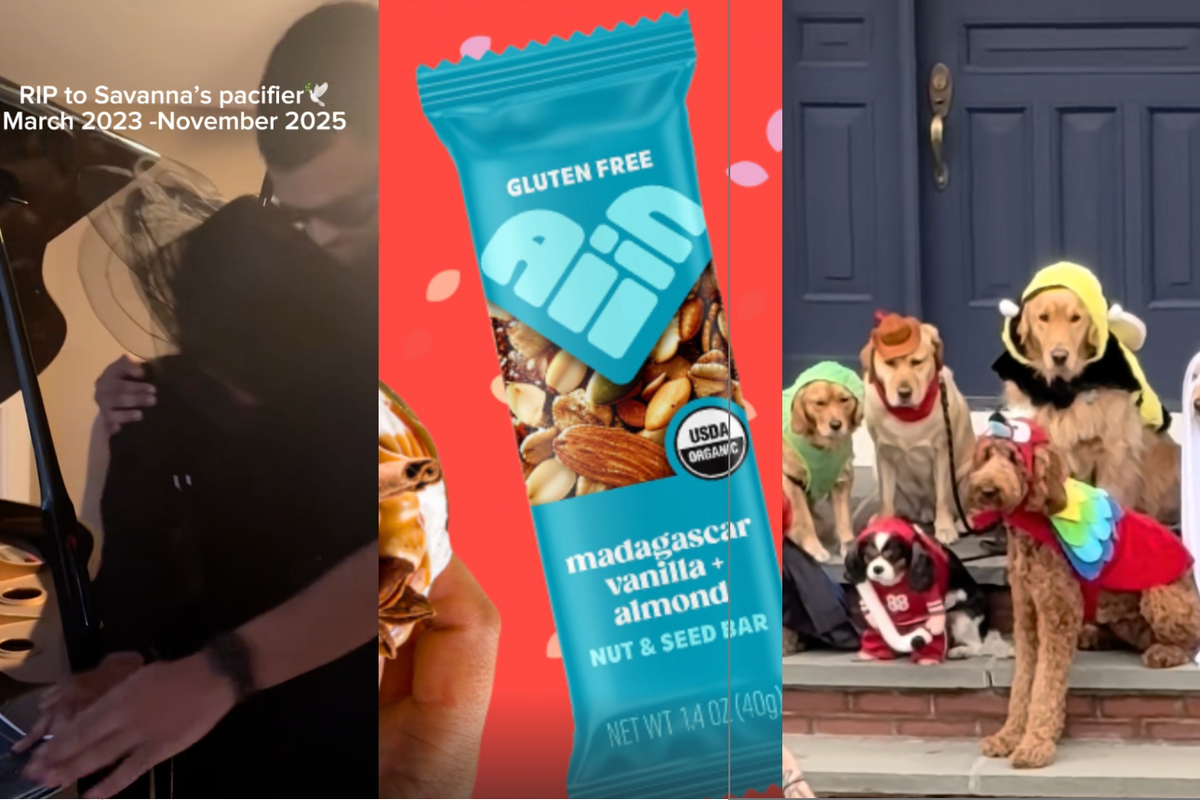The Great Depression, which lasted from 1929-1939, caused economic turmoil worldwide. Families struggled to feed themselves, and went to extreme lengths to stretch food and utilize all available ingredients.
Known as the Greatest Generation (those born between 1901 and 1927), their resourcefulness resulted in a number of creative (and delicious) recipes that remain relevant today. Home chefs and bakers shared their Great Depression recipes on Reddit that have been passed down and are still enjoyed today to help others get inventive and save money.
From soups and stews to cakes, these are 17 Great Depression recipes to try.
- YouTube www.youtube.com
Soups, Stews and More
Beef and Noodles
"My grandmas go to: Bag of egg noodles 1 can of creamed corn 1 can Campbells chicken noodle soup 1 lb ground beef. Salt and pepper to taste. Brown ground beef, add all other ingredients, add enough water or light chicken stock to cover noodles if needed. Bring to boil, and reduce to a simmer for about 15 minutes, take off the heat and let it rest 10 minutes before serving with buttered white bread. I still make this to this day. My kids loved it too. Basically homemade Hamburger Helper." - -__Doc__-
Hoover Stew
Ingredients
1 box noodles
A can of tomatoes
1 package of hot dogs, or 1 can of sausage or meat
A can of corn, peas or beans
2-4 cups water
Instructions
"Mix all ingredients together in a pot until boiling. Then simmer for 15-20 minutes until the noodles are tender. If you have aromatics, onion and garlic would be a great addition. If not, the recipe is great as is." - Josuaross54
Zaprezna soup
"Depression soup... make a roux, add salt pepper and caraway seeds. Add water to make a thick soup texture. Use an egg or two mixed with flour and salt pepper and mix together to make dumplings.. drop into the soup to cook.. This was called zaprezna soup or depression soup. We ate it often in the 60's after my dad abandoned us. Money was short but this soup was good." - User Unknown
Chipped Beef On Toast
Ingredients
8 oz. dried beef jerky
2 tbsp butter or oil
4 tbsp flour
4 cups milk
Salt and pepper to taste
Sliced homemade bread, for serving
Instructions
"Add jerky and oil to a pan over medium heat. Cook until the meat softens, about 3-4 minutes. Stir in your flour and cook for 1-2 minutes. Add milk and bring to a low boil. Allow sauce to thicken for up to 5 minutes. Season with salt and pepper if you have it. Serve over homemade bread, toasted if desired." - Josuaross54
Rivel Soup
"In Ohio…My mom would cook Rivel Soup when I was a kid in 80s and 90s. She still makes it. It’s milk based with flour dough balls in it. I hate it. Sometimes they would fry potatoes and put them in the soup." - Vegetable_Record_855
Potato Soup
Ingredients
4 large potatoes, peeled and sliced (or 2 cans of potatoes)
2 garlic cloves, chopped
One carrot, sliced
A can of meat, sausage, or hot dogs (optional)
3 cups water or stock
3 cups milk
Any herbs you have on-hand
Salt to taste
Instructions
"Slice all your potatoes, garlic, and carrots. Add to a soup pot with the meat, water, and milk. Bring to a boil and reduce the heat, keeping the mix at a low simmer. Then, cook for 30 minutes until all veggies are tender. Add herbs and salt, if using. Serve hot." - Josuaross54
Tuna Fish Stew
"My mother's family always made tuna fish stew. It is celery, potatoes, canned tuna fish, milk, and hard boiled eggs. Sautee the celery until half way cooked, throw in some chopped potatoes and water. Cook until the potatoes are done. Thin the stew with some milk. Throw in chopped hard boil eggs. Salt and pepper to taste Serve over stale bread. It was cheap, quick, and really filling." - RoseNoire4
@foodwandererGreat Depression Cooking Recipe #greatdepression #recipe #cooking #frugalmeals #cookingonabudget #nostalgia #friedpotatoes #hotdogs #foodwanderer #tastetest #SplashSummerVibe
Sides
Baked Beans
Ingredients
1 package soaked dried beans, or 2 cans of beans
One tomato, chopped
1 onion, chopped
2 cloves garlic, chopped
2 tbsp lard
Two tbsp molasses
One cup water
Instructions
"Soak your beans, if using dried, overnight and drain the liquid. Prepare your veggies by chopping. Omit any vegetable that you do not have on-hand. Add lard to a stock pot and cook your vegetables until tender. Add the beans, molasses, and water. Cook all together with a lid on for 2-3 hours or until the beans have your desired consistency. Add more water if needed.
Milk Potatoes
"Milk potatoes. Fry sliced potatoes with salt, pepper and a bit of onion until almost done. Pour milk over potatoes and simmer until potatoes are cooked through." - kms811•6y ago
Ash Cakes
"Ash cakes got their name because different renditions are cooked in the hot white ash of your campfire. These are only 3 ingredients but are filling and have a great texture.
Ingredients
½ cup cornmeal
1 cup meat stock or water
2 tbsp lard or grease
Instructions
Mix both ingredients together in a bowl and allow to sit overnight to hydrate the cornmeal. Pat into a bread pan and refrigerate or add to your cool storage before allowing to set up. The next day, slice into 1-inch slices and fry in melted lard. Serve hot and crispy." - Josuaross54
Sweets
Potato Donuts
"Potato donuts 🍩 from depression era cooking with Dylan Hollis." - BainbridgeBorn
Wacky Cake
"If you have interest in baking, make a wacky cake. It’s a chocolate cake that has no milk, butter, or eggs, because those items were scarce during the Depression, but it is so good! The recipe I linked has more steps, but I’ve known a lot of people to literally just dump and mix everything in the baking dish." - gwhite81218
@bdylanhollisThe cake without butter, eggs or milk #baking #vintage #cooking #cake
Rice Pudding
Ingredients
1 cup rice
2 cups milk
2 tbsp butter
3 tbsp honey, maple syrup, or molasses
Pinch of cinnamon
"Combine all ingredients in a small saucepan and cook over low heat, about 20 minutes, stirring frequently. Taste for doneness and cook an additional 5 minutes, tasting until desired consistency. Serve warm." - Josuaross54
Tomato Soup Cake
"Tomato soup cake." - AxelCanin
Water Pie
"Water pie 😋😍." - AxelCanin
Mock Apple Pie
"There was a thing for 'apple' pie made with Ritz crackers my grandmother made some time ago (she was born 1901 so def Depression life).https://www.allrecipes.com/recipe/9545/mock-apple-pie/ That recipe looks more complicated than the one grandma made, but there are a number of recipes online for it, including one made by Ritz, on the box." - User Unknown
Hard Time Pudding
"Batter: 1 cup flour
1/2 cup white sugar
1/2 cup raisins (Optional, I hate them)
3 tsp Baking powder
1/2 cup water
Syrup: 1 1/2 cup Brown sugar
1 TBSP. butter/marg.
1 tsp vanilla
1 1/2 - 2 cup water
Mix together flour, sugar, raisins, Baking powder, and water. Pour into a baking dish. In a sauce pan combine brown sugar, butter, water bring to boil then add vanilla and pour over the batter. Bake at 300 º for 1/2 hour." - MsBean18





 Bed Bugs Belarus GIF
Bed Bugs Belarus GIF  Bed bugs are about the size of an apple seed.
Bed bugs are about the size of an apple seed.  bed bugs
bed bugs  Checking mattresses for signs of bed bugs at a hotel can help you avoid bringing them home.
Checking mattresses for signs of bed bugs at a hotel can help you avoid bringing them home. 
 Stayin Alive GIF by Bee Gees
Stayin Alive GIF by Bee Gees 
 Team meeting chaos: one employee silently pleads for help.
Team meeting chaos: one employee silently pleads for help. Overcoming fears: Shadow looms large, but courage stands firm.
Overcoming fears: Shadow looms large, but courage stands firm. Confused expression against a bright yellow background.
Confused expression against a bright yellow background.
 BabyCenter's Top 10 baby names for 2025.Canva
BabyCenter's Top 10 baby names for 2025.Canva The name Luca has seen a rise in popularity.
The name Luca has seen a rise in popularity.  Susannah has climbed over 3,000 spots on the baby name chart.
Susannah has climbed over 3,000 spots on the baby name chart.  Pope Francis passed away in April 2025.
Pope Francis passed away in April 2025.  How do you choose a name for a brand new human?
How do you choose a name for a brand new human?